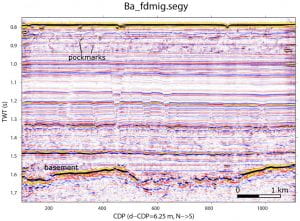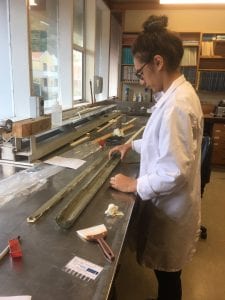The second half of 2020, luckily, was very busy for our Marine Geophysicists with two successful, major cruises.
CSEM for gas hydrates on the Hikurangi Margin, R/V Tangaroa TAN 2012, 1 – 13 Nov. 2020
R/V Tangaroa voyage TAN 2012 aimed at controlled-source electromagnetic (CSEM) survey of gas-hydrate bearing sediment on the southern Hikurangi Margin using Scripps’ system. Gas hydrate, as an insulator, is known to increase sediment resistivity. Beyond CSEM, we collected TOPAS sub-bottom profile, water-column echosounder, and multibeam data.
From our group, Ingo Pecher and Laurenz Boettger took part. The voyage was led by Peter Kannberg at the Scripps Institution of Oceanography, with Karsten Kroeger (GNS Science) and Ingo Pecher as co-leaders. It was funded by the Ministry of Business, Innovation, and Employment (MBIE; Tangaroa Reference Group), the US National Science Foundation and the MBIE Endeavour grant “Economic Opportunities and Environmental Implications of Energy Extraction from Gas Hydrates”.
Chatham Rise pockmarks, R/V Tangaroa TAN 2006, 26 June – 17 July 2020:
R/V Tangaroa voyage TAN 2006 aimed at investigating pockmarks on the Chatham Rise and their potential link to the release of geologic CO2. We hypothesize that CO2 originating from the subducted Hikurangi Plateau is released episodically during glacial-stage maxima forming pockmarks.
Despite adverse weather, we acquired pseudo-3D seismic data in a 6×2 km2 block (densely spaced 2-D seismic data) and 300 km of 2-D seismic lines using NIWA’s high-resolution seismic system. Seismic data quality is excellent (see image). We also acquired almost 3000 km of TOPAS sub-bottom profiler lines and multibeam bathymetry.
Ingo Pecher, Michael Macnaughtan, Laurenz Boettger, and Declan Andrew took part from our group. The voyage was led by Ingo Pecher and Jess Hillman (GNS Science) and funded by MBIE (Tangaroa Reference Group), the Marsden Fund grant “Geologic champagne: What controls sudden release of CO2 at glacial terminations on the Chatham Rise?” and a GNS Science Large Project Investment Fund.
Image: Example of 2-D line in 3-D seismic cube. We obtained clear images down to basement.


